NorthEast Radio Watch 3/31/2025: Jim Quinn Signs Off
In this week’s issue… Remembering Pittsburgh's Quinn - Seven Mountains enters Harrisburg - My launches new brands - Ryan out at B101 - More cuts at Radio Vermont - Another AM deleted
Text and photos by SCOTT FYBUSH
Given the way the weather works in that part of the world, it’s perhaps no surprise that all three of your editor’s recent trips to Minneapolis and St. Paul, Minnesota have come in the summer. (You want to go chasing towers in a Minnesota February? Me either.)
It is, however, a somewhat odder coincidence that all three trips have been in August – and that all three have come with exactly four years between them. In 2005, the Twin Cities were the start and end point of a Big Trip that stretched north to Duluth and International Falls and eastward across Wisconsin. In 2009, we were back for a briefer visit. And then in 2013, a first-ever joint convention among all of the nation’s major DX clubs brought us back to Minneapolis for a long weekend of radio camaraderie, followed by what became Big Trip 2013: a weeklong journey across southern Minnesota and into the Dakotas before returning to the Twin Cities via St. Cloud. For the next few weeks here on Site of the Week, we’ll be recounting that trip – and we start right in downtown Minneapolis early on a Saturday morning.
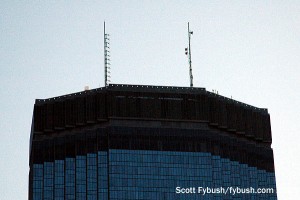 |
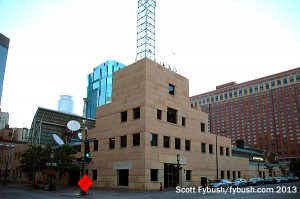 |
Before we even get to our first tour stop, we look up to notice some big changes atop downtown’s tallest office tower. The IDS Center had a brief moment in the sun in the 1970s as a master FM site for the market’s biggest stations, but they moved out to the tower farm in Shoreview en masse, leaving IDS behind for a while without much full-time broadcast at all, just auxes for most of the Shoreview signals. But the combination of a translator boom and some clever engineering has once again made IDS a fairly important site. It’s now the main site for community station KFAI (90.3 Minneapolis), religious KNOF (95.3 St. Paul) and Cumulus sports talker WGVZ (105.7 Eden Prairie), as well as an ever-growing forest of translators, most of them associated with the Clear Channel cluster or its partners over at EMF Broadcasting. In that view from above, that’s all the auxes (mostly in the 35-40 kW ERP range) combined into the antenna on the west tower (on the left in this view), with KNOF’s single bay above WGVZ’s two on the east (right) pole.
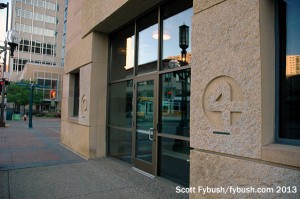 |
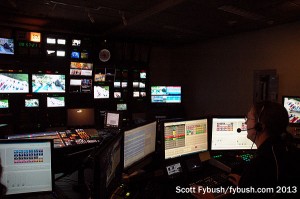 |
But we’re not actually here to see IDS (though we’d like to someday). Instead, we’re hustling over to South 11th Street, on the south side of downtown, for a chance to watch our longtime friend Adam Chernow direct the Saturday morning news at CBS O&O WCCO-TV (Channel 4).
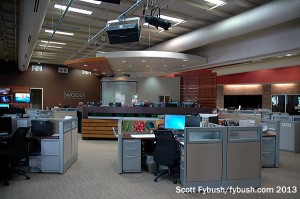 |
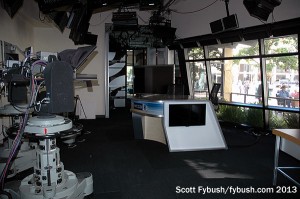 |
Later in this column, we’ll examine more about the history of the building where channel 4 started in 1949; suffice it to say that after more than 30 years in a building that was never even designed for TV, WCCO-TV moved over here in 1983 to a custom-designed home of its own, and a most distinctive one at that, clad in local stone with a distinctive modern design.
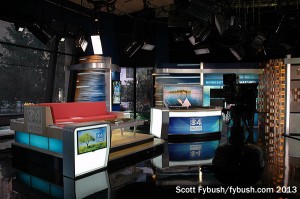 |
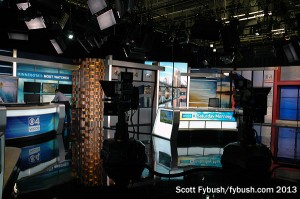 |
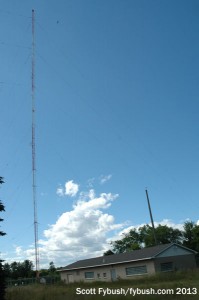
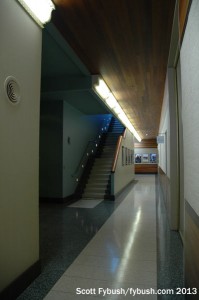
Inside, the building stretches along a long axis of a wood-ceilinged hallway that parallels the street: at one end, the big studio has been renovated to look out through shaded windows at a plaza set back from the street. That plaza is often part of the news: it’s been used for everything from yoga demonstrations to live bands.
Along the street side of the hallway, there’s a neat workflow that stretches out in order: next to the studio is the control room, where the Ross OverDrive automation system lets Adam preside nearly solo over a fairly complex morning juggling act: multiple pedestal cameras in the studio, plus a handheld camera roaming from a live band in the studio out to the plaza for exterior shots, plus beauty cams up on the roof and at several other locations around the Cities.
Master control comes next, and then there’s a jog in the hallway past the main lobby entrance before we get to the spacious newsroom, which also comes with big streetside windows to provide a live backdrop to another news desk. We didn’t go upstairs, but I’m told that’s where sales and business offices are located.
Interestingly, WCCO-TV has never shared studio space with its radio sister. By the time channel 4’s owners, the “Twin Cities Newspapers” consortium of the Minneapolis Star and Tribune and the St. Paul Pioneer Press and Dispatch, bought WCCO (830) in 1952, WCCO’s then-owner CBS had already made the radio station at home in the same building at 625 Second Avenue South where it still resides today. We saw those studios in 2005 and they haven’t changed much; we also saw the WCCO(AM) transmitter site back then, and it’s changed just a little.
But before we take you inside this historic site, north of Minneapolis in Coon Rapids, we overshoot by a few miles to show you something not many AM stations can boast: WCCO has a completely separate off-site auxiliary transmitter facility just north of Coon Rapids. This had been the site of what’s now KMNQ (1470 Brooklyn Park) before it moved to its current location, and when 1470 moved out, WCCO took over for its aux.
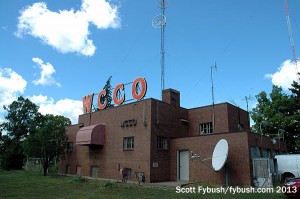 |
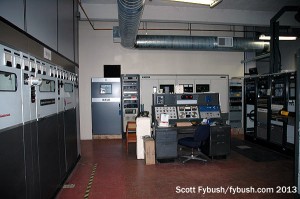 |
We didn’t get inside the auxiliary site, but the DX convention included a nice tour of the main site in Coon Rapids, whose long history we explored in depth back in Big Trip 2005. (Capsule version: this is one of the oldest AM sites in continuous use, possibly even the oldest, having signed on from another building on the property in 1924. The current building dates to 1931, the tower to 1938.)
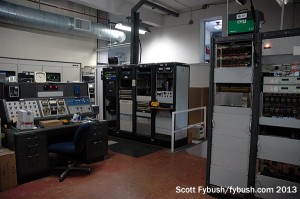 |
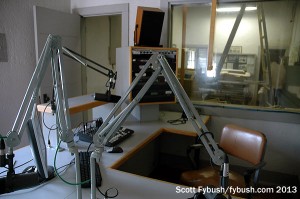 |
The big change between then and now is that in addition to the (now-decommissioned) Continental aux transmitter and the Harris DX50 that was the main in 2005, there’s now a compact Nautel 50 kW transmitter just to the left of the DX50, neatly installed in an extension of the wall that used to end on the left side of the Harris.
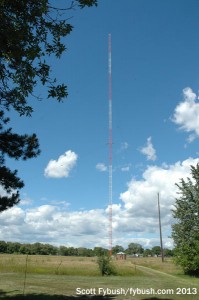 |
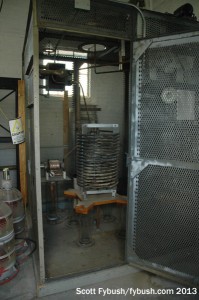 |
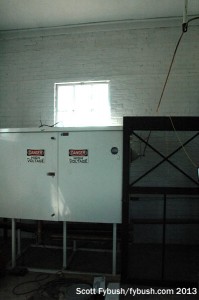 |
As befits a station with multiple levels of backup capacity, they’ve also built out an emergency studio here in one of the rooms overlooking the transmitter room, just in case there’s ever a reason WCCO can’t operate from its usual downtown digs.
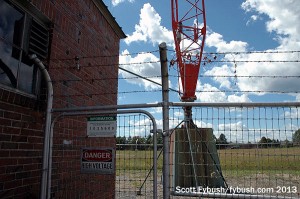 |
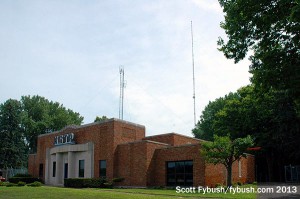 |
From WCCO at the far northern end of the market, we swing around to the northeast corner of the metro and the Twin Cities’ other legacy 50 kW AM signal. For many decades, KSTP competed fiercely with WCCO, first on radio and later on TV – KSTP-TV (Channel 5) was the Cities’ first TV station, followed fairly quickly by what became WCCO-TV on channel 4. (We saw the KSTP-TV studios back in 2009 and featured them here.)
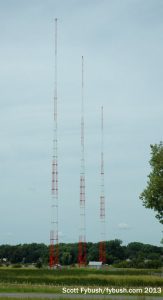 |
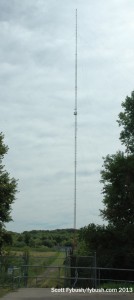 |
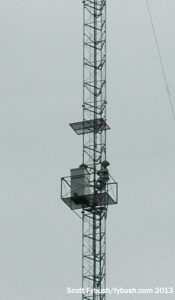 |
Since 1940, KSTP’s transmitter has been located alongside US 61 in Maplewood, at a spot that’s now about halfway between the I-694 beltway and the US 36 freeway. We showed you the exterior of this site on our 2005 Big Trip and noted some of its oddities, but further research (and a visit inside!) has brought out much more of what turns out to be a very unusual story here indeed.
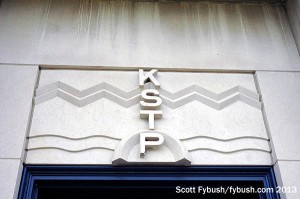 |
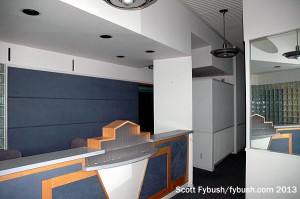 |
KSTP’s early history is fairly straightforward: founded in 1928 as a merger of two upstart stations, KFOY and Stanley Hubbard’s WAMD, it soon settled down on 1460 kilocycles with studios in both Minneapolis and St. Paul and a transmitter site southeast of St. Paul at a site designated as “Radio Center, Minnesota.” In 1936, KSTP moved from “Radio Center” to a site at Snelling Avenue and Highway C north of St. Paul, using a vertical non-directional antenna with 25,000 watts. The development of directional antenna technology in the 1930s allowed KSTP to jump to 50,000 watts fulltime from this site eight miles or so east of its previous Snelling Avenue location, using a three-tower DA to protect co-channel WJSV (later WTOP) in Washington, DC.
(Unusually for a radio station, KSTP maintains a very comprehensive and mostly accurate recap of its own history on its website, complete with some great pictures of those earlier sites.)
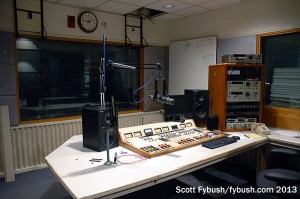 |
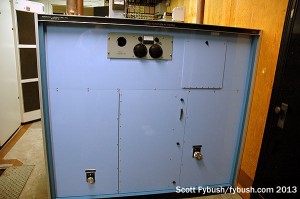 |
The building Hubbard built in 1940 is the same one that’s still on the site today, but it’s been through a lot of changes over the years. At the studio end, KSTP had moved its Minneapolis studio from the Hotel Radisson to the grandly-named Radio City theater in 1939, but that location didn’t last long. A decade later, KSTP built a state-of-the-art studio plant for both radio and TV (with a tower out back for KSTP-TV 5) straddling the Minneapolis-St. Paul boundary on University Avenue, and that location has been the center of the Hubbard Broadcasting empire ever since. (Radio City, meanwhile, became the first studio home of WTCN-TV, the station that became today’s WCCO-TV; channel 4 renovated the building extensively and remained there until 1983.)
For a few years in the 1980s, though, KSTP(AM)’s studios weren’t there. In 1985, Hubbard moved the AM station’s operations out here to Maplewood, carving out space on the south side of the transmitter building for studios, offices and a new lobby built with Art Deco touches – and the original Deco lighting that had graced the building four decades earlier. The studio and office space stayed in use out here until 1999, when Hubbard renovated the University Avenue facility and brought the AM studios back in with its TV and FM sisters. (More on the FMs in a moment…)
After a long run as a talk competitor to WCCO, KSTP went all-sports a few years back as “ESPN Radio 1500,” and that’s what it’s doing these days. The Twins had a long run at this spot on the dial before team owner Carl Pohlad bought a station of his own (it’s now “K-Twin” KTWN 96.3). And one more fairly recent change: after many decades in which KSTP uneasily shared 1500 with WTOP in Washington and a more recent directional arrival, WLQV in Detroit, Hubbard’s purchase of WTOP a few years ago made KSTP a sister station to its DC rival on the channel. If it still mattered, Hubbard could probably dramatically realign its 1500 signals to improve the always-problematic nighttime coverage from WTOP – but in the meantime, WTOP’s wildly profitable all-news format migrated from AM over to FM, leaving 1500 in DC as the home of “Federal News Radio” WFED, which depends as much on streaming as on AM to reach its target audience.
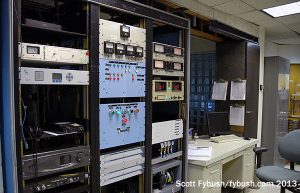 |
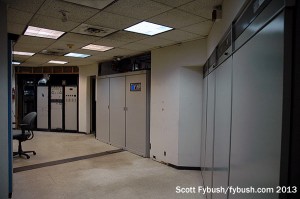 |
The transmitter room at the center of the building is basically what’s left of the original transmitter room after the studio space was carved out. Today, it boasts a Harris 3DX50 as the main transmitter (center), with an older MW50 for backup (right) and a Continental FM transmitter (left) as a last-ditch backup for KSTP-FM (94.5), which makes its usual home a few miles northwest of here at the big Telefarm tower complex in Shorewood. Behind the AM transmitters, an equipment room includes a phase rotator designed to give a better match between the transmitter and the unusual Franklin-style daytime tower out back, which consists of a 179-degree radiator stacked atop another 179-degree radiator, with an insulator and feedpoint at the middle.
The current KSTP-FM represents Hubbard’s second stab at FM. As with so many aspects of broadcasting (including shortwave radio and color TV), Hubbard was a pioneer of FM in the late 1930s and into the 1940s, but the first iteration of KSTP-FM (as with so many early FMs) didn’t make it. Its spot at 102.1 on the dial went dark and eventually was claimed by what’s now Clear Channel’s KEEY. When FM started to turn around again in the early 1960s, Hubbard reapplied for FM, this time on 94.5 – and that in turn appears to have been part of the impetus for a big change out here in Maplewood.
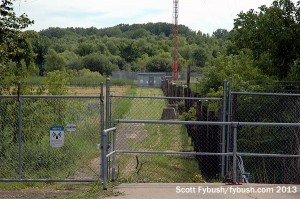 |
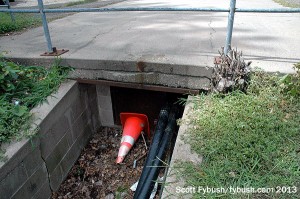 |
When we first saw this site back in 2005, we’d thought the unusual tower configuration here dated all the way back to 1940: the three-tower self-supporting DA on the west side of Highway 61 for KSTP’s directional night signal, and on the east side, the 659-foot segmented Franklin-type tower out behind the transmitter building.
In fact, this is a more modern configuration: when the site was built in 1940, it was a one-site operation, running two separate directional patterns from what’s now the night site across the busy highway from the transmitter building. The Franklin tower for day use (and to hold the KSTP-FM antenna before the main FM site was moved to Shorewood in the early 1970s) didn’t come along until 1965. (I’m told the current Franklin is actually a 1981 replacement for that tower.)
And therein lies a very, very big mystery: with all the open land available around the Twin Cities in 1940, why did Hubbard originally build its transmitter building across the highway (busy, even then) from the towers? The only answer that seems to make sense, from where we sit, is this: the land on the west side where the (now) night site sits is very low and swampy, while the transmitter building sits on higher, drier ground. Was avoiding flooding worth the cost of putting a culvert under the highway? Perhaps someday soon, we can update this Tower Site installment with a definitive answer.
Meanwhile, our Big Trip recap heads out of Minneapolis at this point: next week, it’s a look at the radio and TV of Mankato.
Thanks to WCCO-TV’s Adam Chernow, KSTP’s Jon Blomstrand and WCCO radio’s Craig Walters for the tours – and to Mark Durenberger and his amazing convention crew, too!
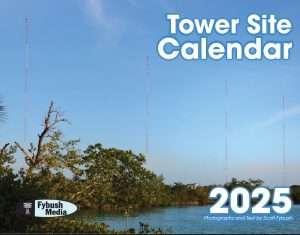
And if you don’t have your Tower Site Calendar, now’s the time!
If you’ve been waiting for the price to come down, it’s now 30 percent off!
This year’s cover is a beauty — the 100,000-watt transmitter of the Voice Of America in Marathon, right in the heart of the Florida Keys. Both the towers and the landscape are gorgeous.
And did you see? Tower Site of the Week is back, featuring this VOA site as it faces an uncertain future.
Other months feature some of our favorite images from years past, including some Canadian stations and several stations celebrating their centennials (buy the calendar to find out which ones!).
We still have a few of our own calendars left – as well as a handful of Radio Historian Calendars – and we are still shipping regularly.
The proceeds from the calendar help sustain the reporting that we do on the broadcast industry here at Fybush Media, so your purchases matter a lot to us here – and if that matters to you, now’s the time to show that support with an order of the Tower Site Calendar. (And we have the Broadcast Historian’s Calendar for 2025, too. Why not order both?)
Visit the Fybush Media Store and place your order now for the new calendar, get a great discount on previous calendars, and check out our selection of books and videos, too!
Next week: Big Trip 2013, Part 2 – Mankato, Minnesota
In this week’s issue… Remembering Pittsburgh's Quinn - Seven Mountains enters Harrisburg - My launches new brands - Ryan out at B101 - More cuts at Radio Vermont - Another AM deleted
Tower Site goes Jeeping (and fixing a flat tire!) up in the mountains of northwest New Jersey
In this week’s issue… New signal for Boston's WJIB - "New Standards" changes stations - New home for Maine FM - Remembering NYC's Diaz, Maine's "Mr. Mike," Albany's McGrath, Rochester's Petschke
A look at two of the Voice of America facilities that were abruptly shuttered this month